FC301 Statistics: Unemployment Rate Analysis Report (1971-2019)
VerifiedAdded on 2022/08/08
|9
|1692
|27
Report
AI Summary
This statistics investigation report analyzes the UK unemployment rate from 1971 to 2019. The study utilizes data from the LMS, presenting yearly, quarterly, and monthly data. The report employs descriptive statistics, including mean, median, mode, skewness, and frequency distributions, to analyze unemployment trends. Graphical representations such as histograms, bar graphs, and line graphs are used to visualize the data and identify fluctuations. The analysis reveals a positive skewness in the unemployment rate, with the mean exceeding the median. The report also compares monthly unemployment rates in 1971 and 2019, highlighting the fluctuating nature of the rate in 2019 compared to the increasing trend in 1971. The quarterly analysis from 1971 to 2019 shows fluctuations in the rate of unemployment, with a peak in 1985 and a decreasing trend from 2013 onward. The report concludes that the rate of unemployment is decreasing as compared to 1971.
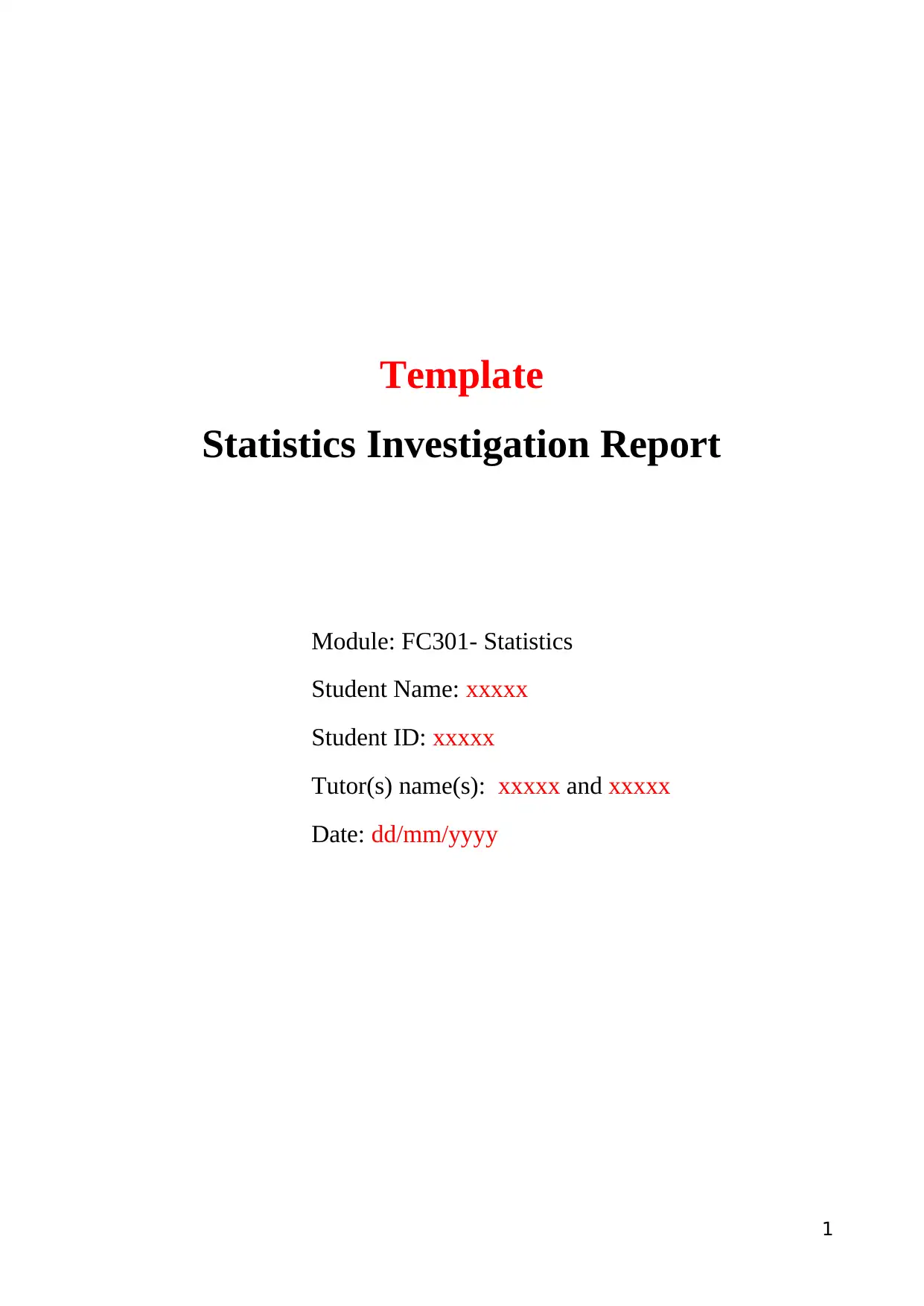
Template
Statistics Investigation Report
Module: FC301- Statistics
Student Name: xxxxx
Student ID: xxxxx
Tutor(s) name(s): xxxxx and xxxxx
Date: dd/mm/yyyy
1
Statistics Investigation Report
Module: FC301- Statistics
Student Name: xxxxx
Student ID: xxxxx
Tutor(s) name(s): xxxxx and xxxxx
Date: dd/mm/yyyy
1
Paraphrase This Document
Need a fresh take? Get an instant paraphrase of this document with our AI Paraphraser
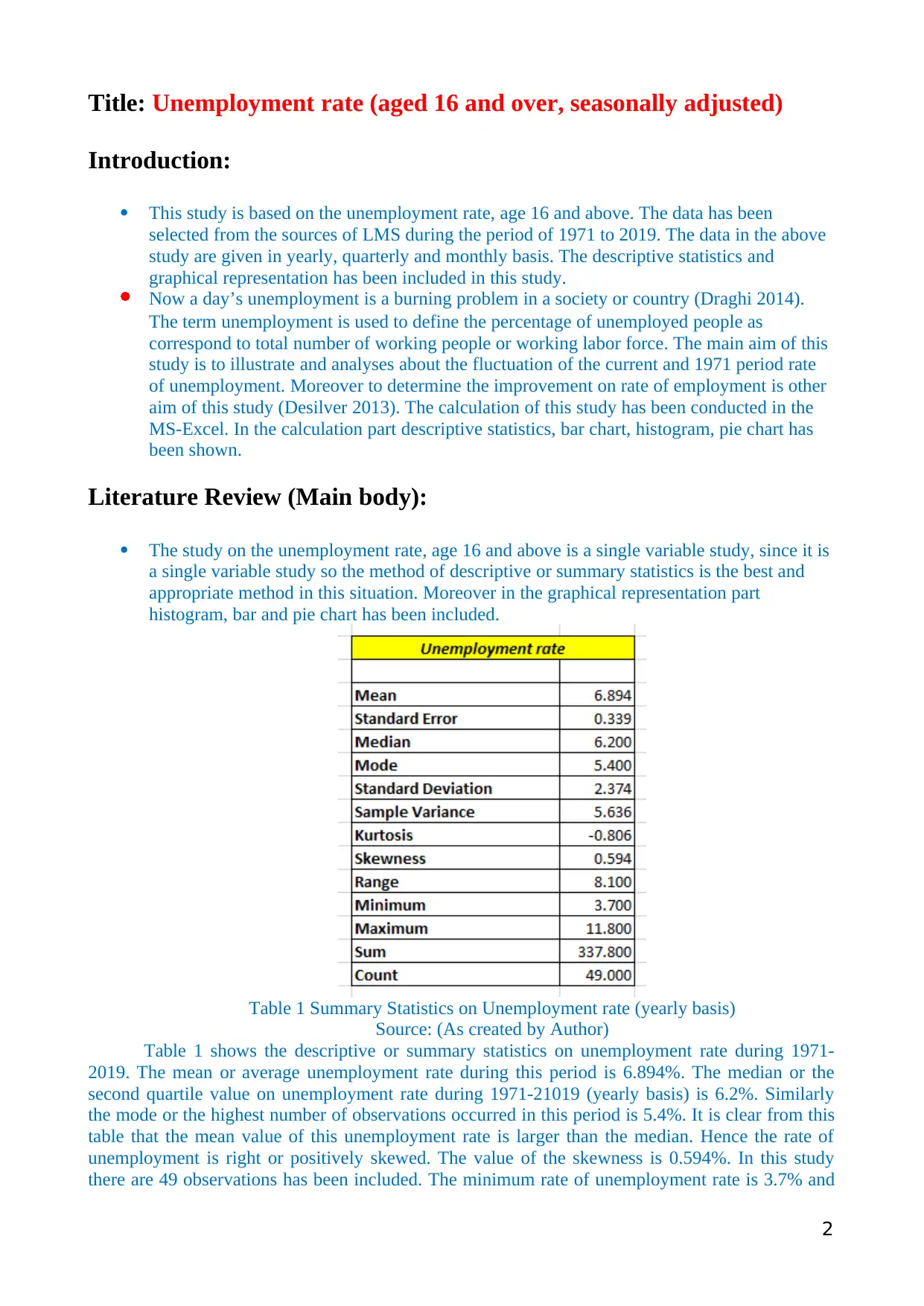
Title: Unemployment rate (aged 16 and over, seasonally adjusted)
Introduction:
This study is based on the unemployment rate, age 16 and above. The data has been
selected from the sources of LMS during the period of 1971 to 2019. The data in the above
study are given in yearly, quarterly and monthly basis. The descriptive statistics and
graphical representation has been included in this study.
Now a day’s unemployment is a burning problem in a society or country (Draghi 2014).
The term unemployment is used to define the percentage of unemployed people as
correspond to total number of working people or working labor force. The main aim of this
study is to illustrate and analyses about the fluctuation of the current and 1971 period rate
of unemployment. Moreover to determine the improvement on rate of employment is other
aim of this study (Desilver 2013). The calculation of this study has been conducted in the
MS-Excel. In the calculation part descriptive statistics, bar chart, histogram, pie chart has
been shown.
Literature Review (Main body):
The study on the unemployment rate, age 16 and above is a single variable study, since it is
a single variable study so the method of descriptive or summary statistics is the best and
appropriate method in this situation. Moreover in the graphical representation part
histogram, bar and pie chart has been included.
Table 1 Summary Statistics on Unemployment rate (yearly basis)
Source: (As created by Author)
Table 1 shows the descriptive or summary statistics on unemployment rate during 1971-
2019. The mean or average unemployment rate during this period is 6.894%. The median or the
second quartile value on unemployment rate during 1971-21019 (yearly basis) is 6.2%. Similarly
the mode or the highest number of observations occurred in this period is 5.4%. It is clear from this
table that the mean value of this unemployment rate is larger than the median. Hence the rate of
unemployment is right or positively skewed. The value of the skewness is 0.594%. In this study
there are 49 observations has been included. The minimum rate of unemployment rate is 3.7% and
2
Introduction:
This study is based on the unemployment rate, age 16 and above. The data has been
selected from the sources of LMS during the period of 1971 to 2019. The data in the above
study are given in yearly, quarterly and monthly basis. The descriptive statistics and
graphical representation has been included in this study.
Now a day’s unemployment is a burning problem in a society or country (Draghi 2014).
The term unemployment is used to define the percentage of unemployed people as
correspond to total number of working people or working labor force. The main aim of this
study is to illustrate and analyses about the fluctuation of the current and 1971 period rate
of unemployment. Moreover to determine the improvement on rate of employment is other
aim of this study (Desilver 2013). The calculation of this study has been conducted in the
MS-Excel. In the calculation part descriptive statistics, bar chart, histogram, pie chart has
been shown.
Literature Review (Main body):
The study on the unemployment rate, age 16 and above is a single variable study, since it is
a single variable study so the method of descriptive or summary statistics is the best and
appropriate method in this situation. Moreover in the graphical representation part
histogram, bar and pie chart has been included.
Table 1 Summary Statistics on Unemployment rate (yearly basis)
Source: (As created by Author)
Table 1 shows the descriptive or summary statistics on unemployment rate during 1971-
2019. The mean or average unemployment rate during this period is 6.894%. The median or the
second quartile value on unemployment rate during 1971-21019 (yearly basis) is 6.2%. Similarly
the mode or the highest number of observations occurred in this period is 5.4%. It is clear from this
table that the mean value of this unemployment rate is larger than the median. Hence the rate of
unemployment is right or positively skewed. The value of the skewness is 0.594%. In this study
there are 49 observations has been included. The minimum rate of unemployment rate is 3.7% and
2
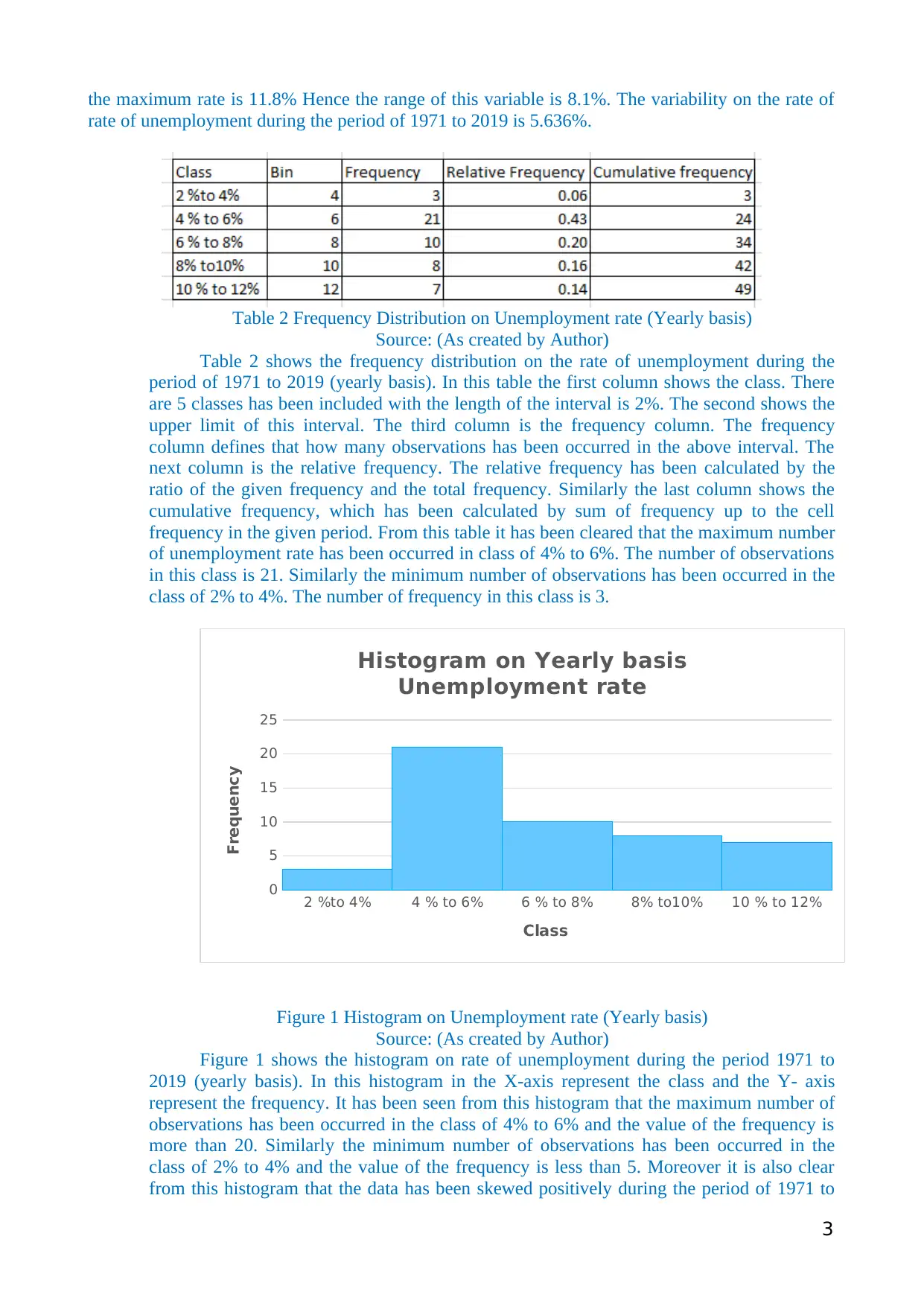
the maximum rate is 11.8% Hence the range of this variable is 8.1%. The variability on the rate of
rate of unemployment during the period of 1971 to 2019 is 5.636%.
Table 2 Frequency Distribution on Unemployment rate (Yearly basis)
Source: (As created by Author)
Table 2 shows the frequency distribution on the rate of unemployment during the
period of 1971 to 2019 (yearly basis). In this table the first column shows the class. There
are 5 classes has been included with the length of the interval is 2%. The second shows the
upper limit of this interval. The third column is the frequency column. The frequency
column defines that how many observations has been occurred in the above interval. The
next column is the relative frequency. The relative frequency has been calculated by the
ratio of the given frequency and the total frequency. Similarly the last column shows the
cumulative frequency, which has been calculated by sum of frequency up to the cell
frequency in the given period. From this table it has been cleared that the maximum number
of unemployment rate has been occurred in class of 4% to 6%. The number of observations
in this class is 21. Similarly the minimum number of observations has been occurred in the
class of 2% to 4%. The number of frequency in this class is 3.
2 %to 4% 4 % to 6% 6 % to 8% 8% to10% 10 % to 12%
0
5
10
15
20
25
Histogram on Yearly basis
Unemployment rate
Class
Frequency
Figure 1 Histogram on Unemployment rate (Yearly basis)
Source: (As created by Author)
Figure 1 shows the histogram on rate of unemployment during the period 1971 to
2019 (yearly basis). In this histogram in the X-axis represent the class and the Y- axis
represent the frequency. It has been seen from this histogram that the maximum number of
observations has been occurred in the class of 4% to 6% and the value of the frequency is
more than 20. Similarly the minimum number of observations has been occurred in the
class of 2% to 4% and the value of the frequency is less than 5. Moreover it is also clear
from this histogram that the data has been skewed positively during the period of 1971 to
3
rate of unemployment during the period of 1971 to 2019 is 5.636%.
Table 2 Frequency Distribution on Unemployment rate (Yearly basis)
Source: (As created by Author)
Table 2 shows the frequency distribution on the rate of unemployment during the
period of 1971 to 2019 (yearly basis). In this table the first column shows the class. There
are 5 classes has been included with the length of the interval is 2%. The second shows the
upper limit of this interval. The third column is the frequency column. The frequency
column defines that how many observations has been occurred in the above interval. The
next column is the relative frequency. The relative frequency has been calculated by the
ratio of the given frequency and the total frequency. Similarly the last column shows the
cumulative frequency, which has been calculated by sum of frequency up to the cell
frequency in the given period. From this table it has been cleared that the maximum number
of unemployment rate has been occurred in class of 4% to 6%. The number of observations
in this class is 21. Similarly the minimum number of observations has been occurred in the
class of 2% to 4%. The number of frequency in this class is 3.
2 %to 4% 4 % to 6% 6 % to 8% 8% to10% 10 % to 12%
0
5
10
15
20
25
Histogram on Yearly basis
Unemployment rate
Class
Frequency
Figure 1 Histogram on Unemployment rate (Yearly basis)
Source: (As created by Author)
Figure 1 shows the histogram on rate of unemployment during the period 1971 to
2019 (yearly basis). In this histogram in the X-axis represent the class and the Y- axis
represent the frequency. It has been seen from this histogram that the maximum number of
observations has been occurred in the class of 4% to 6% and the value of the frequency is
more than 20. Similarly the minimum number of observations has been occurred in the
class of 2% to 4% and the value of the frequency is less than 5. Moreover it is also clear
from this histogram that the data has been skewed positively during the period of 1971 to
3
⊘ This is a preview!⊘
Do you want full access?
Subscribe today to unlock all pages.

Trusted by 1+ million students worldwide
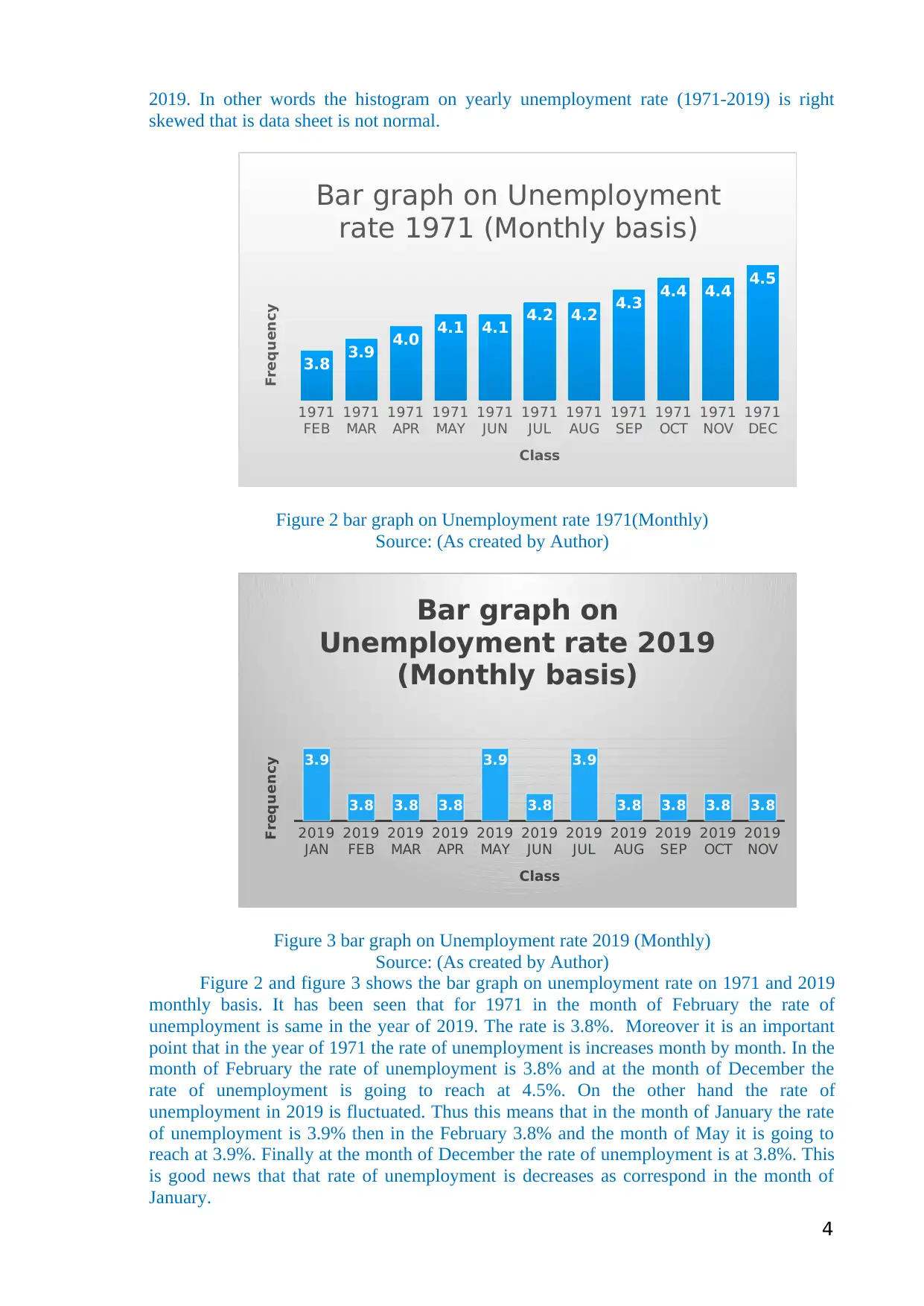
2019. In other words the histogram on yearly unemployment rate (1971-2019) is right
skewed that is data sheet is not normal.
1971
FEB
1971
MAR
1971
APR
1971
MAY
1971
JUN
1971
JUL
1971
AUG
1971
SEP
1971
OCT
1971
NOV
1971
DEC
3.8 3.9 4.0 4.1 4.1 4.2 4.2 4.3 4.4 4.4 4.5
Bar graph on Unemployment
rate 1971 (Monthly basis)
Class
Frequency
Figure 2 bar graph on Unemployment rate 1971(Monthly)
Source: (As created by Author)
2019
JAN
2019
FEB
2019
MAR
2019
APR
2019
MAY
2019
JUN
2019
JUL
2019
AUG
2019
SEP
2019
OCT
2019
NOV
3.9
3.8 3.8 3.8
3.9
3.8
3.9
3.8 3.8 3.8 3.8
Bar graph on
Unemployment rate 2019
(Monthly basis)
Class
Frequency
Figure 3 bar graph on Unemployment rate 2019 (Monthly)
Source: (As created by Author)
Figure 2 and figure 3 shows the bar graph on unemployment rate on 1971 and 2019
monthly basis. It has been seen that for 1971 in the month of February the rate of
unemployment is same in the year of 2019. The rate is 3.8%. Moreover it is an important
point that in the year of 1971 the rate of unemployment is increases month by month. In the
month of February the rate of unemployment is 3.8% and at the month of December the
rate of unemployment is going to reach at 4.5%. On the other hand the rate of
unemployment in 2019 is fluctuated. Thus this means that in the month of January the rate
of unemployment is 3.9% then in the February 3.8% and the month of May it is going to
reach at 3.9%. Finally at the month of December the rate of unemployment is at 3.8%. This
is good news that that rate of unemployment is decreases as correspond in the month of
January.
4
skewed that is data sheet is not normal.
1971
FEB
1971
MAR
1971
APR
1971
MAY
1971
JUN
1971
JUL
1971
AUG
1971
SEP
1971
OCT
1971
NOV
1971
DEC
3.8 3.9 4.0 4.1 4.1 4.2 4.2 4.3 4.4 4.4 4.5
Bar graph on Unemployment
rate 1971 (Monthly basis)
Class
Frequency
Figure 2 bar graph on Unemployment rate 1971(Monthly)
Source: (As created by Author)
2019
JAN
2019
FEB
2019
MAR
2019
APR
2019
MAY
2019
JUN
2019
JUL
2019
AUG
2019
SEP
2019
OCT
2019
NOV
3.9
3.8 3.8 3.8
3.9
3.8
3.9
3.8 3.8 3.8 3.8
Bar graph on
Unemployment rate 2019
(Monthly basis)
Class
Frequency
Figure 3 bar graph on Unemployment rate 2019 (Monthly)
Source: (As created by Author)
Figure 2 and figure 3 shows the bar graph on unemployment rate on 1971 and 2019
monthly basis. It has been seen that for 1971 in the month of February the rate of
unemployment is same in the year of 2019. The rate is 3.8%. Moreover it is an important
point that in the year of 1971 the rate of unemployment is increases month by month. In the
month of February the rate of unemployment is 3.8% and at the month of December the
rate of unemployment is going to reach at 4.5%. On the other hand the rate of
unemployment in 2019 is fluctuated. Thus this means that in the month of January the rate
of unemployment is 3.9% then in the February 3.8% and the month of May it is going to
reach at 3.9%. Finally at the month of December the rate of unemployment is at 3.8%. This
is good news that that rate of unemployment is decreases as correspond in the month of
January.
4
Paraphrase This Document
Need a fresh take? Get an instant paraphrase of this document with our AI Paraphraser
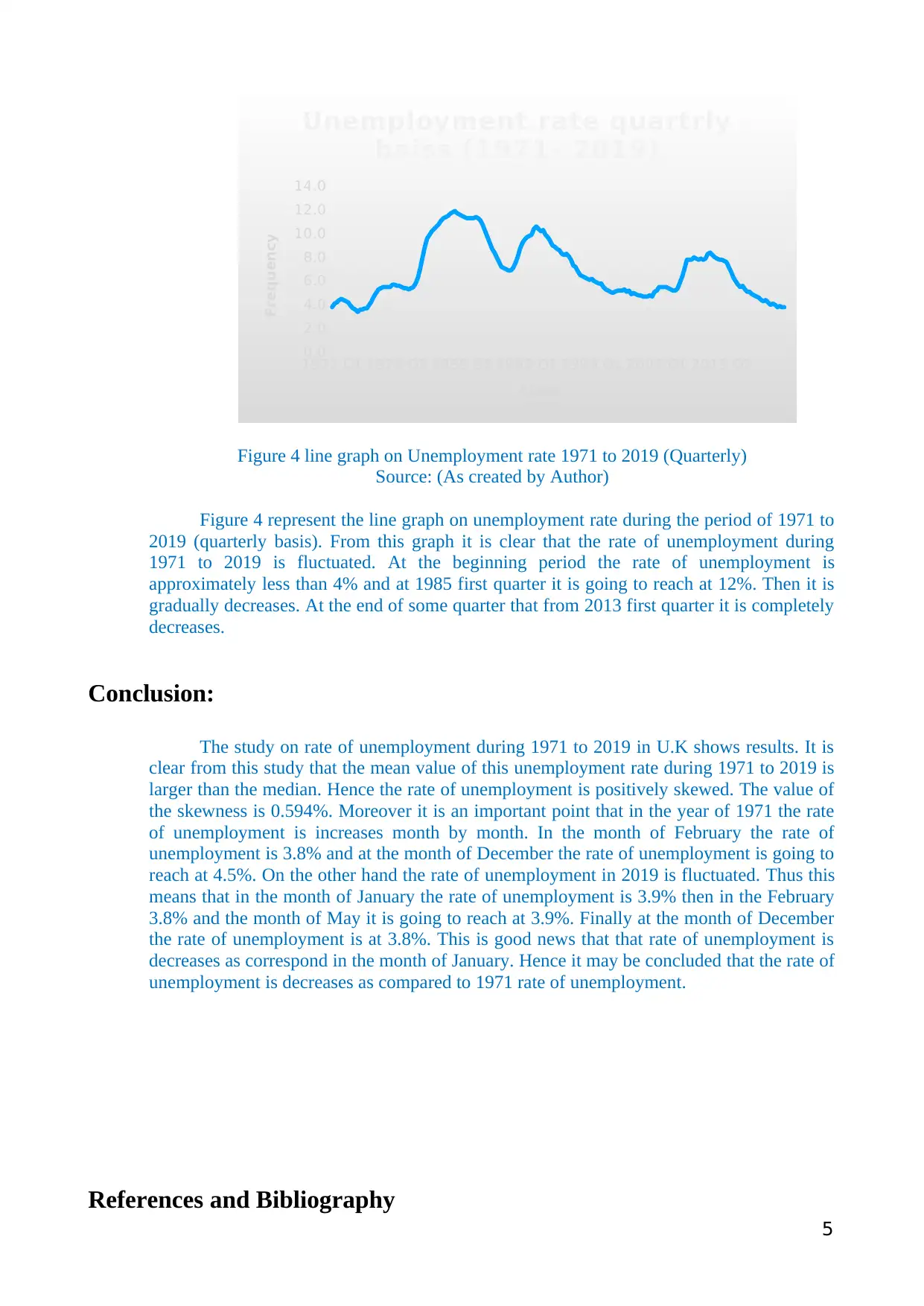
1971 Q1 1978 Q1 1985 Q1 1992 Q1 1999 Q1 2006 Q1 2013 Q1
0.0
2.0
4.0
6.0
8.0
10.0
12.0
14.0
Unemployment rate quartrly
baiss (1971- 2019)
Class
Frequency
Figure 4 line graph on Unemployment rate 1971 to 2019 (Quarterly)
Source: (As created by Author)
Figure 4 represent the line graph on unemployment rate during the period of 1971 to
2019 (quarterly basis). From this graph it is clear that the rate of unemployment during
1971 to 2019 is fluctuated. At the beginning period the rate of unemployment is
approximately less than 4% and at 1985 first quarter it is going to reach at 12%. Then it is
gradually decreases. At the end of some quarter that from 2013 first quarter it is completely
decreases.
Conclusion:
The study on rate of unemployment during 1971 to 2019 in U.K shows results. It is
clear from this study that the mean value of this unemployment rate during 1971 to 2019 is
larger than the median. Hence the rate of unemployment is positively skewed. The value of
the skewness is 0.594%. Moreover it is an important point that in the year of 1971 the rate
of unemployment is increases month by month. In the month of February the rate of
unemployment is 3.8% and at the month of December the rate of unemployment is going to
reach at 4.5%. On the other hand the rate of unemployment in 2019 is fluctuated. Thus this
means that in the month of January the rate of unemployment is 3.9% then in the February
3.8% and the month of May it is going to reach at 3.9%. Finally at the month of December
the rate of unemployment is at 3.8%. This is good news that that rate of unemployment is
decreases as correspond in the month of January. Hence it may be concluded that the rate of
unemployment is decreases as compared to 1971 rate of unemployment.
References and Bibliography
5
0.0
2.0
4.0
6.0
8.0
10.0
12.0
14.0
Unemployment rate quartrly
baiss (1971- 2019)
Class
Frequency
Figure 4 line graph on Unemployment rate 1971 to 2019 (Quarterly)
Source: (As created by Author)
Figure 4 represent the line graph on unemployment rate during the period of 1971 to
2019 (quarterly basis). From this graph it is clear that the rate of unemployment during
1971 to 2019 is fluctuated. At the beginning period the rate of unemployment is
approximately less than 4% and at 1985 first quarter it is going to reach at 12%. Then it is
gradually decreases. At the end of some quarter that from 2013 first quarter it is completely
decreases.
Conclusion:
The study on rate of unemployment during 1971 to 2019 in U.K shows results. It is
clear from this study that the mean value of this unemployment rate during 1971 to 2019 is
larger than the median. Hence the rate of unemployment is positively skewed. The value of
the skewness is 0.594%. Moreover it is an important point that in the year of 1971 the rate
of unemployment is increases month by month. In the month of February the rate of
unemployment is 3.8% and at the month of December the rate of unemployment is going to
reach at 4.5%. On the other hand the rate of unemployment in 2019 is fluctuated. Thus this
means that in the month of January the rate of unemployment is 3.9% then in the February
3.8% and the month of May it is going to reach at 3.9%. Finally at the month of December
the rate of unemployment is at 3.8%. This is good news that that rate of unemployment is
decreases as correspond in the month of January. Hence it may be concluded that the rate of
unemployment is decreases as compared to 1971 rate of unemployment.
References and Bibliography
5

Bethune, Z., Rocheteau, G. and Rupert, P., 2015. Aggregate unemployment and household
unsecured debt. Review of Economic Dynamics, 18(1), pp.77-100.
Desilver, D., 2013. Black unemployment rate is consistently twice that of whites. Pew Research
Center, 21.
Draghi, M., 2014, August. Unemployment in the euro area. In Speech at the annual central bank
symposium in Jackson Hole (Vol. 22).
Ho, A.D. and Yu, C.C., 2015. Descriptive statistics for modern test score distributions: Skewness,
kurtosis, discreteness, and ceiling effects. Educational and Psychological Measurement, 75(3),
pp.365-388.
Holcomb, Z.C., 2016. Fundamentals of descriptive statistics. Routledge.
Rocheteau, G. and Rodriguez-Lopez, A., 2014. Liquidity provision, interest rates, and
unemployment. Journal of Monetary Economics, 65, pp.80-101.
Appendix:
6
unsecured debt. Review of Economic Dynamics, 18(1), pp.77-100.
Desilver, D., 2013. Black unemployment rate is consistently twice that of whites. Pew Research
Center, 21.
Draghi, M., 2014, August. Unemployment in the euro area. In Speech at the annual central bank
symposium in Jackson Hole (Vol. 22).
Ho, A.D. and Yu, C.C., 2015. Descriptive statistics for modern test score distributions: Skewness,
kurtosis, discreteness, and ceiling effects. Educational and Psychological Measurement, 75(3),
pp.365-388.
Holcomb, Z.C., 2016. Fundamentals of descriptive statistics. Routledge.
Rocheteau, G. and Rodriguez-Lopez, A., 2014. Liquidity provision, interest rates, and
unemployment. Journal of Monetary Economics, 65, pp.80-101.
Appendix:
6
⊘ This is a preview!⊘
Do you want full access?
Subscribe today to unlock all pages.

Trusted by 1+ million students worldwide
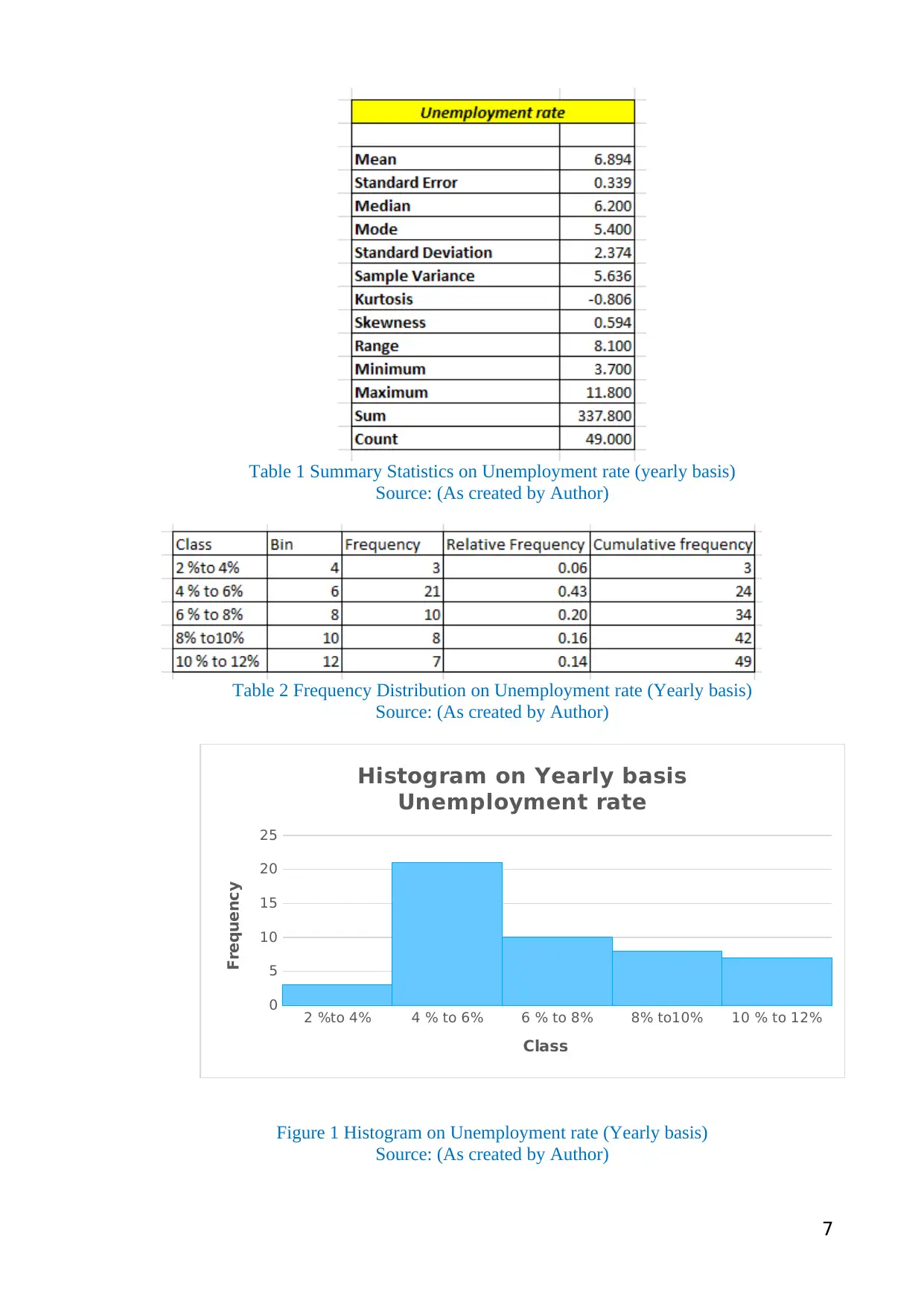
Table 1 Summary Statistics on Unemployment rate (yearly basis)
Source: (As created by Author)
Table 2 Frequency Distribution on Unemployment rate (Yearly basis)
Source: (As created by Author)
2 %to 4% 4 % to 6% 6 % to 8% 8% to10% 10 % to 12%
0
5
10
15
20
25
Histogram on Yearly basis
Unemployment rate
Class
Frequency
Figure 1 Histogram on Unemployment rate (Yearly basis)
Source: (As created by Author)
7
Source: (As created by Author)
Table 2 Frequency Distribution on Unemployment rate (Yearly basis)
Source: (As created by Author)
2 %to 4% 4 % to 6% 6 % to 8% 8% to10% 10 % to 12%
0
5
10
15
20
25
Histogram on Yearly basis
Unemployment rate
Class
Frequency
Figure 1 Histogram on Unemployment rate (Yearly basis)
Source: (As created by Author)
7
Paraphrase This Document
Need a fresh take? Get an instant paraphrase of this document with our AI Paraphraser
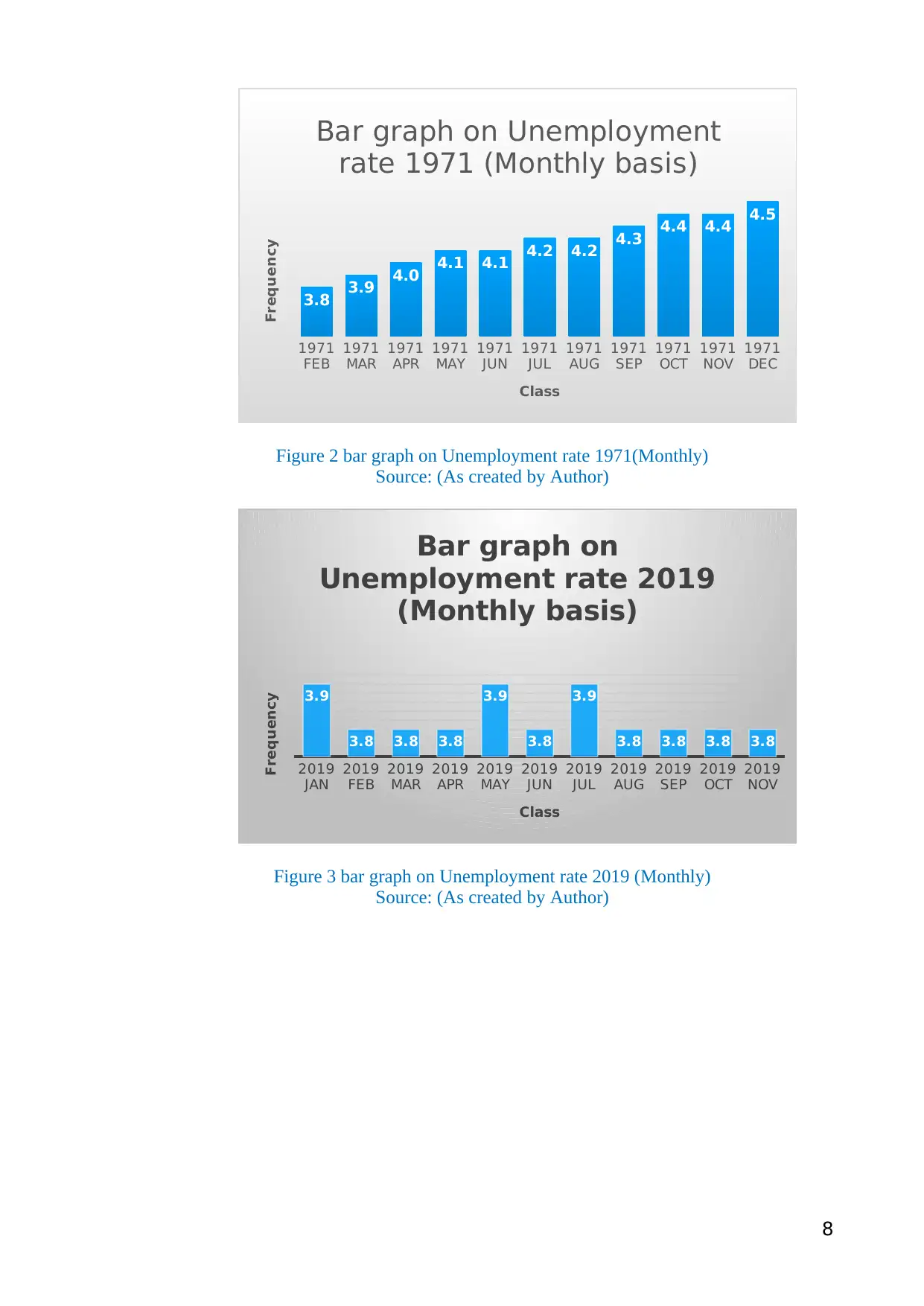
1971
FEB
1971
MAR
1971
APR
1971
MAY
1971
JUN
1971
JUL
1971
AUG
1971
SEP
1971
OCT
1971
NOV
1971
DEC
3.8 3.9 4.0 4.1 4.1 4.2 4.2 4.3 4.4 4.4 4.5
Bar graph on Unemployment
rate 1971 (Monthly basis)
Class
Frequency
Figure 2 bar graph on Unemployment rate 1971(Monthly)
Source: (As created by Author)
2019
JAN
2019
FEB
2019
MAR
2019
APR
2019
MAY
2019
JUN
2019
JUL
2019
AUG
2019
SEP
2019
OCT
2019
NOV
3.9
3.8 3.8 3.8
3.9
3.8
3.9
3.8 3.8 3.8 3.8
Bar graph on
Unemployment rate 2019
(Monthly basis)
Class
Frequency
Figure 3 bar graph on Unemployment rate 2019 (Monthly)
Source: (As created by Author)
8
FEB
1971
MAR
1971
APR
1971
MAY
1971
JUN
1971
JUL
1971
AUG
1971
SEP
1971
OCT
1971
NOV
1971
DEC
3.8 3.9 4.0 4.1 4.1 4.2 4.2 4.3 4.4 4.4 4.5
Bar graph on Unemployment
rate 1971 (Monthly basis)
Class
Frequency
Figure 2 bar graph on Unemployment rate 1971(Monthly)
Source: (As created by Author)
2019
JAN
2019
FEB
2019
MAR
2019
APR
2019
MAY
2019
JUN
2019
JUL
2019
AUG
2019
SEP
2019
OCT
2019
NOV
3.9
3.8 3.8 3.8
3.9
3.8
3.9
3.8 3.8 3.8 3.8
Bar graph on
Unemployment rate 2019
(Monthly basis)
Class
Frequency
Figure 3 bar graph on Unemployment rate 2019 (Monthly)
Source: (As created by Author)
8
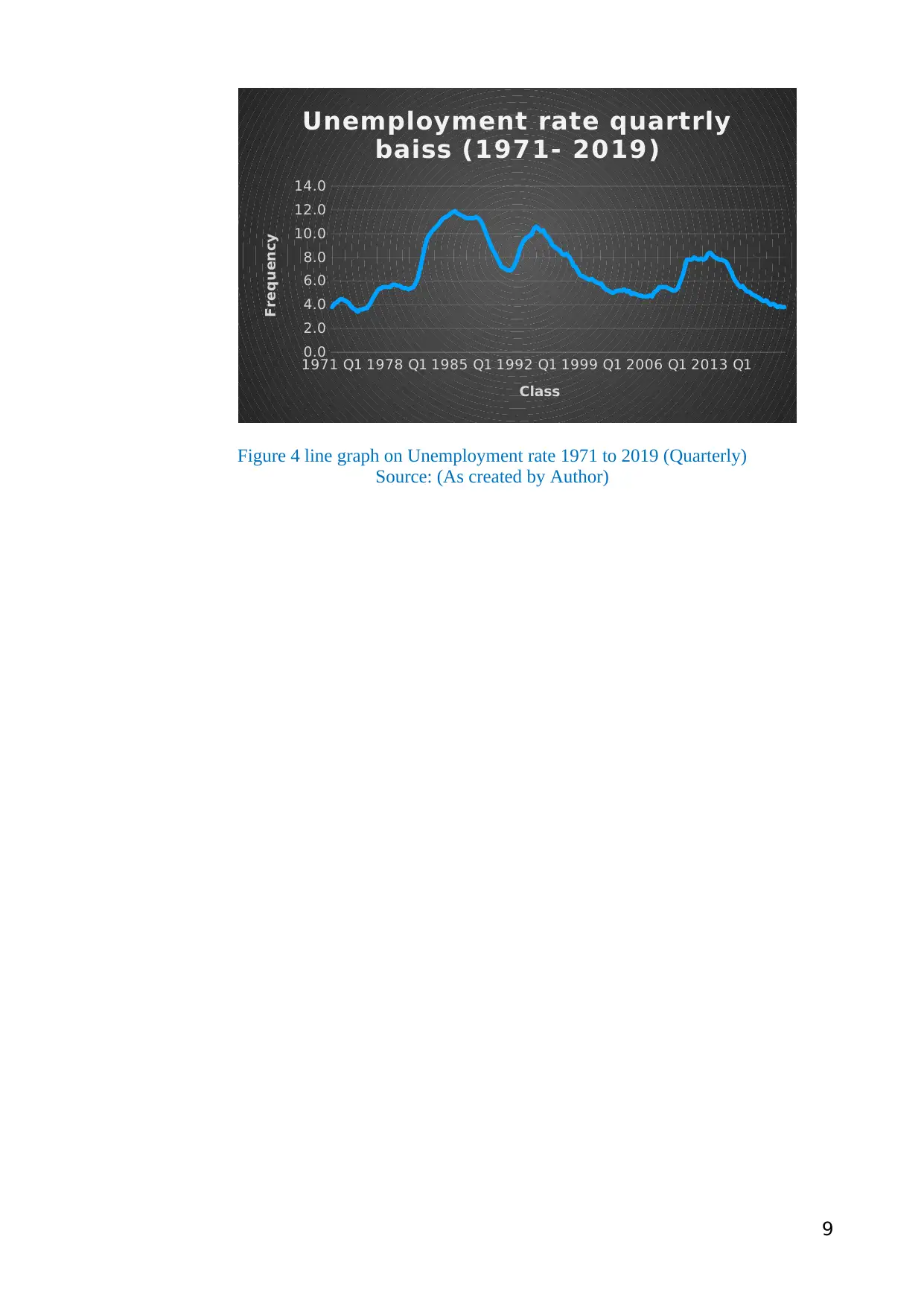
1971 Q1 1978 Q1 1985 Q1 1992 Q1 1999 Q1 2006 Q1 2013 Q1
0.0
2.0
4.0
6.0
8.0
10.0
12.0
14.0
Unemployment rate quartrly
baiss (1971- 2019)
Class
Frequency
Figure 4 line graph on Unemployment rate 1971 to 2019 (Quarterly)
Source: (As created by Author)
9
0.0
2.0
4.0
6.0
8.0
10.0
12.0
14.0
Unemployment rate quartrly
baiss (1971- 2019)
Class
Frequency
Figure 4 line graph on Unemployment rate 1971 to 2019 (Quarterly)
Source: (As created by Author)
9
⊘ This is a preview!⊘
Do you want full access?
Subscribe today to unlock all pages.

Trusted by 1+ million students worldwide
1 out of 9
Related Documents
Your All-in-One AI-Powered Toolkit for Academic Success.
+13062052269
info@desklib.com
Available 24*7 on WhatsApp / Email
![[object Object]](/_next/static/media/star-bottom.7253800d.svg)
Unlock your academic potential
Copyright © 2020–2025 A2Z Services. All Rights Reserved. Developed and managed by ZUCOL.



